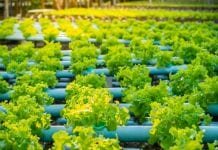
A biodegradable material which effectively acts as an environmentally friendly plastic substitute has arrived from Spawnfoam Ltd.
Vases, packaging, decorative items, insulation boards – in all sectors of activity and at any time of our daily routine we are surrounded by plastic. We have become accustomed to shapes, colours, touch, and the convenience of plastic and its derivatives. We have also become accustomed to throwing them away, without compunction, and replacing them with the latest model.
The result of decades of consumption and waste of plastic materials is now obvious; and the world has never been so sensitive to the need to change our consumption habits. The environment and the planet’s sustainability depend on this change. It is important to use fewer finite resources and make the transition to a circular economy: one without waste. It is urgent now to stop the growth of the Pacific Trash Isles and replace plastic applications with more environmentally friendly alternatives.
Spawnfoam aims to take some of the responsibility of this necessary change in the world, accelerating to a circular economy. The Portuguese biotechnology company is creating innovative biocomposites as greener plastic substitutes.
Spawnfoam biocomposites
These biocomposites are created from agricultural by-products and agroforestry waste bonded and reinforced with fungal mycelium and natural additives. These components make Spawnfoam materials the environment’s best friends – they are biological and biodegradable, which allows them to be returned to the soil at the end of their life cycle, re-entering the productive cycle.
The biodegradability of these materials and the possibility of returning them to the beginning of the production cycle as raw material for a new biocomposite, sets Spawnfoam as a solution capable of contributing to the transition to a Circular Economy, as it generates zero waste in the productive process. Spawnfoam is at the forefront of the new cradle to cradle industrial revolution.
Spawnfoam develops a green and economical technology that contributes to reducing global dependence on fossil fuels and reducing greenhouse gas emissions.
By valuing end-of-life materials such as by-products from the forest and agriculture, Spawnfoam avoids increasing consumption of finite and polluting raw materials. By producing fully biodegradable materials, it prevents the deposit of waste in landfills or in the seas. After use, or at the end of the life cycle, these materials produced by Spawnfoam can be dumped to the ground, as they serve as soil fertiliser.
The technology
Spawnfoam’s biocomposite innovation lies in the technology and raw materials used in its production. Compared to other materials, namely plastics, the innovation lies in the fact that, as previously mentioned, it is based on by-products and waste to create composites and products with multiple applications and high technological value. Innovation is not only technological, scientific and technical, but also conceptual and environmental.
Spawnfoam is engaged in intensive research and development work regarding the production of innovative biocomposites which meet users’ needs. Therefore, they have the experience and technical and scientific knowledge which allows them to create materials and products capable of making a difference in the market and in the world.
The secret is the use of mycelium of fungi to bind and strengthen the raw material (wood chips, sawdust, stalks, straws), forming a biocomposite with characteristics very specific of the region where it is produced, Trás-os-Montes and Alto Douro, in Portugal. The way the mycelium adheres to agriculture and forest by-products and the introduction of natural additives gives biocomposites strength and durability.
What are the biocomposites for?
The biocomposites can be used for everything. The multifaceted nature of Spawnfoam biocomposites makes it possible to transform them into a multitude of products. The company is however currently focusing on specific segments as a way of entering the international market. These include:
- Transplantation pots;
- Insulation for construction;
- Packaging; and
- Decoration.
Transplantation pots
Of all the possible applications, Spawnfoam places particular value on its transplantation pots. Transplantation pots are primarily intended to increase the effectiveness of the transplantation process of nursery trees and plants to their natural habitat. There are countless losses in the process between the germination of the plant at the nursery and its growth in the soil.
Many plants are hopelessly damaged in the transition from the pots to the soil and others end up not surviving after being transplanted. This is due – on the one hand – to the handling of the plant, particularly its roots, and on the other hand, the stress to which the plant is subjected after transplantation.
Spawnfoam pots prevent this damage from occurring. The process of transplantation with the Spawnfoam pots is simpler and subjects the plant to less handling and stress. The pot that supports the growth of the plant in the nursery is later buried in the soil along with it. This keeps the plant always protected in the pot throughout the process and able to withstand and adapt to stress after transplantation. This process is only possible because the pots are biodegradable.
In addition to supporting the plant throughout the entire transplanting process and increasing the effectiveness of its adaptation to the soil, these pots enhance plant growth. Since they are biodegradable, once placed in the soil they begin to decompose and consequently provide nutrients to the plant. In this way, unlike the majority of widely-used materials, Spawnfoam’s biocomposites do not release plastic waste which would be harmful to the plant’s health, nor do they pollute the environment – quite the opposite.
Comparison between Spawnfoam pots and its alternatives
Spawnfoam pots have significant competitive advantages over their direct and indirect competitors. They integrate organic matter good for the plant’s growth, contribute to the retention of water, incorporate beneficial fungi and protect the root.
These pots are easily customised according to plant or soil characteristics or the customer’s logistical needs. In addition, they can incorporate natural fertilisers which enhance a healthier and faster growth of the plant.
Spawnfoam pots are undoubtedly a useful tool for forest preservation. Recent data shows that around 5 million hectares are replanted annually around the world in REDD-plus carbon mitigation projects, which corresponds to a market of around €415m – this is a growing market if we consider the increased global awareness for forest preservation and the use of biodegradable materials and plastic substitutes.
In addition, climate change leads to more and more wildfires, even in typically humid areas, resulting in increased reforestation efforts worldwide, not only by governments, but also by citizens and companies. In this matter, Spawnfoam is at the forefront. It uses and values forest wastes that are used to return trees to the forest. This is a clear approach to the transition to the circular economy, which contributes disruptively to the change that is required in the current consumption paradigm.
Insulation for construction
There are several insulating materials in the construction market, for example petroleum derivatives, such as expanded polystyrene. These materials have been used in construction worldwide because of their effectiveness in thermal and acoustic insulation of buildings and the ease of handling, transportation and storage.
Unfortunately, these petroleum-derived materials are not biodegradable. After use they remain in the environment for many decades and neither the incentives for their reuse or recycling have had an effect on the reduction of their demand.
Spawnfoam presents to the market new solutions for thermal and acoustic insulation, which are equally effective but completely harmless to the environment. The tests already performed prove the reliability, effectiveness and durability of Spawnfoam insulation boards.
Packaging
Spawnfoam produces filling for packaging, with special emphasis on the more disposable, especially in transport and distribution. The filling produced from Spawnfoam’s biocomposites has passed several tensile tests and has been proven to be shock resistant. It is thus asserted as a green alternative to Styrofoam, nowadays commonly used for the protection of packaged articles.
After transport or short use, the Spawnfoam filling can be released to the ground without any harm to the environment. Because it is a biodegradable material, produced from by-products of organic origin, it can be used to fertilise the gardens of the consumer who, for example, just bought a TV or an appliance.
Decoration
The multifaceted character of Spawnfoam’s biocomposites allows its use in a multitude of contexts. Interior design is increasingly disruptive and seeks the use of environmentally friendly plastic substitutes, rather than single-use materials. Spawnfoam is a strong component in the integration of decorative elements, such as vases, lamps, containers, etc. Also, in this field, it contributes to the reduction of the ecological footprint, avoiding the consumption of elements derived from fossil fuels.
Other
Spawnfoam biocomposites are easily handled and moulded to customer requirements with a high potential for customisation, adding or removing details to the final shape of each product. They can, therefore, result in an infinite number of products or applications targeted to different audiences and different sectors of activity. On-demand products are a great competitive advantage of Spawnfoam.
Award-winning technology
Spawnfoam’s disruptive technology has won awards in Portugal and Europe. In the last year the company has approved applications for the SME Instrument, Horizon 2020 and Support the Transition to a Circular Economy – Environmental Fund, as part of the Portuguese Government funding programmes. They have made it to the Climate Launchpad final in Scotland, which will take place in November, Spawnfoam has also won prizes for technological innovation and environmental sustainability such as Norte Empreendedor and Inovar+.
These recognitions have also given Spawnfoam the attention of the Portuguese media, where it has gained prominence in the biggest national communication groups. Spawnfoam has also been present in various national and international events in green technologies and innovation.
Sustained growth, from Portugal to the world
The idea of creating biodegradable alternative plastic substitutes arose in 2013, when Pedro Mendes, Spawnfoam co-founder, was a student of mechanical engineering at the University of Trás-os-Montes and Alto Douro, Portugal. In a mechanics of materials class, publications on innovative processes for the formation of materials from organic matter were presented. That moment Pedro realised that he could develop a viable alternative to plastic from existing by-products in the region of Trás-os-Montes and Alto Douro.
That year, Pedro Mendes competed with the idea Spawnfoam to the Portuguese programme “Passaporte para o Empreendedorismo” (Passport for Entrepreneurship), to support the development of business ideas. The idea was selected among hundreds, in what would become the first step towards its materialisation.
After a period maturing the technology and the business model, Spawnfoam was selected for the COHiTEC program, which is an international training course in technology commercialisation, aimed at supporting the valuation of knowledge produced in Portuguese research and development institutions. The participation in this programme was fundamental to the creation – in January 2017 – of Spawnfoam, Ltd. Since its foundation, the company has been developing and perfecting the technology, having recently entered the market.
In addition to its high production capacity and innovation, Spawnfoam relies on a network of partners to obtain raw material, technology validation, product design and marketing. As research and development partners, they have the University of Trás-os-Montes and Alto Douro, while the Regia Douro Park – science and technology park of Vila Real is the company’s business validation and location entity. They also have MUSKI Design Studio, in product design, and Esporão, as a pilot user of biodegradable packaging. In acoustic solutions, they count on Artnovion.
Spawnfoam is an innovative and pioneering vision for the world, but with well-founded local roots. All the knowledge and used raw materials come from the North of Portugal, which contributes greatly to the economic and social development of the area; which is one of the most underdeveloped regions in Europe. The use of agricultural by-products and forest residues brings more profit to local economic agents in these areas within the supply chain. In addition, the large-scale production of these biocomposites results in the creation of multiple jobs, many of which are intended for specialised technicians, as the technological and scientific nature of the production process demands it. Being able to do so in an ageing and deserted region makes Spawnfoam entrepreneurs proud.
The necessary leap
After the phases of technology stabilisation and market entry, the company is now focused
on its growth, namely through increasing production capacity. The next phase will be the construction of a production unit capable of responding to the global market’s demands and requirements. Spawnfoam is seeking partners and funding to make that quantitative leap and move to a new level of technology and business development.
In addition to the growth of the company, Spawnfoam has the ambition to create a European cluster, which will characterise and develop the technology to use chitin as a structural adhesive. For this, they are in the market to develop contacts with potential partners throughout Europe.
In parallel, for this company it is also essential to invest in technology licensing. Spawnfoam’s research and development capability has given rise to the creation of different technologies, processes and products, which it is important to validation and value.
To make this necessary leap, Spawnfoam has been active on several fronts. It has sought to increase recognition of the advantages of its technology to investors and the media. It has established partnerships with players with a scale and know-how to enable the transition to a medium-sized production unit, to improve technological development, to improve product design and to widen the commercial dimension. It has tried to value research work through publications in magazines, as a form of affirmation and credibility in the market. It seeks to carry out actions of social responsibility and environmental awareness in schools and universities to capture the future.
The future
Spawnfoam aims to be a reference in technological innovation for the creation of environmentally friendly materials and sustainable and renewable plastic substitutes. It is hoped that its contribution will be decisive for the disruptive change in the consumption paradigm, currently based on materials derived from fossil fuels.
This is the great responsibility of Spawnfoam, to contribute to the demonstration and dissemination of the advantages of using biodegradable materials in multiple contexts. More than a business, this is the consumption pattern that will ensure the sustainability of the planet’s resources.
The world of today and, most of all, the world of tomorrow is grateful.


















